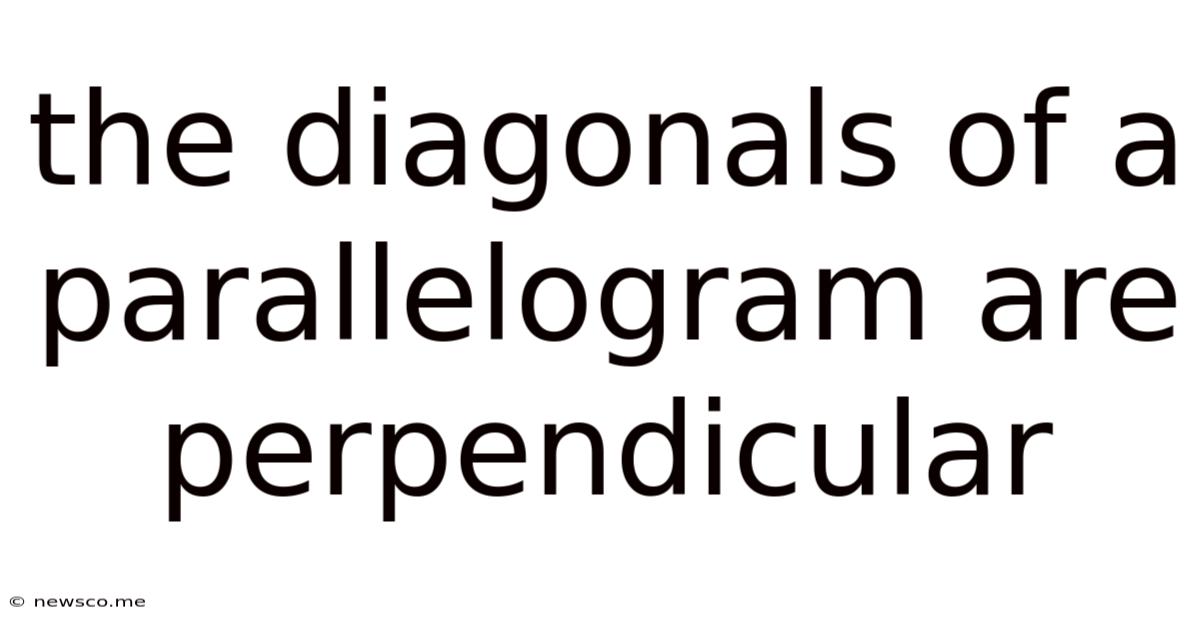The Diagonals Of A Parallelogram Are Perpendicular
News Co
Apr 21, 2025 · 5 min read

Table of Contents
The Diagonals of a Parallelogram are Perpendicular: A Deep Dive into Geometry
The statement "the diagonals of a parallelogram are perpendicular" is not always true. While it's a common misconception, the diagonals of a parallelogram are only perpendicular under a specific circumstance: when the parallelogram is a rhombus or a square. This article will delve into the geometric properties of parallelograms, rhombuses, and squares, explaining why this condition holds true and exploring the broader implications of these relationships.
Understanding Parallelograms
A parallelogram is a quadrilateral (a four-sided polygon) with opposite sides parallel and equal in length. This fundamental property leads to several other crucial characteristics:
- Opposite angles are equal: Angles A and C are equal, as are angles B and D.
- Consecutive angles are supplementary: Angles A and B (or B and C, C and D, or D and A) add up to 180 degrees.
- Diagonals bisect each other: The diagonals intersect at a point where each diagonal is divided into two equal segments.
However, the angle at which the diagonals intersect is not necessarily 90 degrees. This is where the distinction between parallelograms and their special cases becomes important.
Key Differences: Parallelogram vs. Rhombus vs. Square
Let's clarify the relationships between these shapes:
- Parallelogram: A quadrilateral with opposite sides parallel. This is the most general case.
- Rhombus: A parallelogram with all sides equal in length. This adds a constraint to the parallelogram's definition.
- Square: A rhombus with all angles equal to 90 degrees (and therefore all sides equal). This is the most specific case, inheriting all the properties of both parallelograms and rhombuses.
Why the Diagonals of a Rhombus (and Square) are Perpendicular
The key to understanding why the diagonals of a rhombus (and consequently, a square) are perpendicular lies in examining the properties of its diagonals and their relationship to the sides.
Consider a rhombus ABCD. Let's denote the intersection of the diagonals AC and BD as point O. Because the diagonals of a parallelogram bisect each other, we know that AO = OC and BO = OD.
Now, let's focus on triangle ABO and triangle ADO. In a rhombus, all sides are equal (AB = BC = CD = DA). Since the diagonals bisect each other, AO is a common side to both triangles. Therefore, we have:
- AB = AD (sides of the rhombus)
- AO = AO (common side)
- BO = OD (diagonals bisect each other)
By the SSS (Side-Side-Side) congruence postulate, triangle ABO is congruent to triangle ADO. This congruence implies that angles AOB and AOD are equal. Since these angles are supplementary (they add up to 180 degrees), each must equal 90 degrees. Therefore, the diagonals are perpendicular.
This same logic applies to a square, as a square is a special case of a rhombus.
Mathematical Proof using Vectors
We can also prove the perpendicularity of diagonals in a rhombus using vector mathematics. Let's represent the vertices of the rhombus as vectors:
- A = 0 (origin)
- B = b
- D = d
Since it's a parallelogram, C = b + d.
The diagonal AC is represented by the vector c = b + d. The diagonal BD is represented by the vector b - d.
Two vectors are perpendicular if their dot product is zero. Let's calculate the dot product of the diagonals:
c • b - d = (b + d) • (b - d) = b • b - b • d + d • b - d • d
Since the dot product is commutative (b • d = d • b), the equation simplifies to:
b • b - d • d = ||b||² - ||d||²
In a rhombus, all sides have equal length. Therefore, ||b|| = ||d||. This means:
||b||² - ||d||² = 0
Thus, the dot product of the diagonals is zero, proving that the diagonals of a rhombus are perpendicular. This proof elegantly demonstrates the relationship using vector algebra.
Practical Applications and Real-World Examples
The properties of rhombuses and their perpendicular diagonals have numerous applications in various fields:
- Engineering and Construction: Rhombus shapes are often employed in structural designs to distribute forces effectively. The perpendicularity of diagonals aids in calculating stresses and strains within the structure.
- Art and Design: The symmetry and geometric properties of rhombuses find applications in artistic creations, mosaics, and architectural patterns.
- Computer Graphics and Game Development: Rhombuses are utilized in creating various shapes and textures, leveraging their unique geometric attributes.
- Crystallography: The structure of certain crystals exhibits rhombic patterns, and understanding the diagonal properties is crucial in studying their internal arrangements.
Exploring Further: Beyond the Rhombus
While the diagonals of a parallelogram are not generally perpendicular, their properties provide valuable insights into the geometry of quadrilaterals. Studying the specific conditions under which the diagonals are perpendicular (i.e., in rhombuses and squares) enhances our understanding of geometric relationships and their implications in different fields.
Conclusion
The statement that the diagonals of a parallelogram are perpendicular is only true for specific types of parallelograms – rhombuses and squares. This crucial distinction is rooted in the geometric properties of these shapes. Understanding this difference and the underlying mathematical proofs provides a deeper appreciation of geometric principles and their practical applications across various domains. The concepts discussed here are fundamental to geometry and serve as a building block for further exploration in higher-level mathematics. The use of both geometric arguments and vector calculus underlines the versatility and robustness of these proofs, solidifying our understanding of this important geometric concept.
Latest Posts
Related Post
Thank you for visiting our website which covers about The Diagonals Of A Parallelogram Are Perpendicular . We hope the information provided has been useful to you. Feel free to contact us if you have any questions or need further assistance. See you next time and don't miss to bookmark.